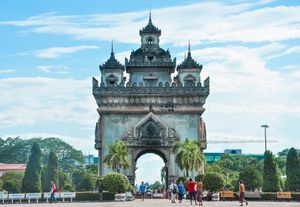Area: 91,429 square miles.
Neighbours: Thailand, Burma, China, Vietnam and Cambodia.
Environment: Laos has a tropical monsoon climate. Much of its terrain consists of rugged mountains (Phou Bia 2,871 metres) with plains and plateaus. The Mekong River runs through the southwest of the country and most people live along its delta. There are floods in the rainy season. Laos is landlocked.
Population: 6 million.
Infant mortality: 89 deaths per 1,000 live births.
Life expectancy: 54 years.
Ethnic groups: A complex mix of 138 ethnic groups. Lao-Tai 59%; Mon-Khmer 31%; Hmong-Mien 7%; Sino-Tibetan 2.5%; others, including Chinese 0.5%.
Languages: Lao (official), French, English and many ethnic languages and dialects.
Literacy: Male 68%, female 38%
Capital: Vientiane (286,000).
Economy: Although a relatively small amount of land is suitable for agriculture, Laos has a subsistence agricultural economy, with rice as a staple food. Over half of Laos is thickly forested. Exports include wood products, garments, electricity, coffee and tin. There is good hydroelectric power capacity, but the nation’s infrastructure is undeveloped with, for example, no railways. It is one of the world’s largest illegal producers of opium and is involved with other drugs.
Religions: Buddhist 61%; traditional ethnic (animist) 31%; Muslim 1%; Roman Catholic 1%; Protestant 1%; non-religious and others 5%.
History: Laos achieved independence from France in July 1949. It was drawn into the Vietnam War during the 1960s and 70s. Today, it is one of the few remaining communist states in the world.





